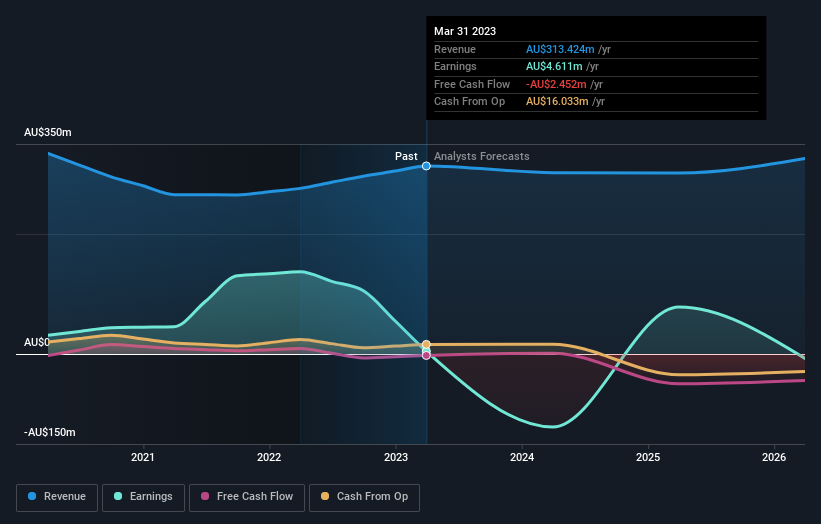Insiders of Australian Agricultural Company Limited (ASX:AAC) must be frustrated after market cap dropped AU$81m since recent purchases
Key Insights
- Insiders appear to have a vested interest in Australian Agricultural's growth, as seen by their sizeable ownership
- The largest shareholder of the company is Bryan Glinton with a 52% stake
- Insiders have bought recently
Every investor in Australian Agricultural Company Limited (ASX:AAC) should be aware of the most powerful shareholder groups. And the group that holds the biggest piece of the pie are individual insiders with 72% ownership. That is, the group stands to benefit the most if the stock rises (or lose the most if there is a downturn).
Notably, insiders have bought shares recently. However, with market cap down by AU$81m over the last week, their expectations were far from met.
Let's delve deeper into each type of owner of Australian Agricultural, beginning with the chart below.
Check out our latest analysis for Australian Agricultural

What Does The Institutional Ownership Tell Us About Australian Agricultural?
Many institutions measure their performance against an index that approximates the local market. So they usually pay more attention to companies that are included in major indices.
We can see that Australian Agricultural does have institutional investors; and they hold a good portion of the company's stock. This implies the analysts working for those institutions have looked at the stock and they like it. But just like anyone else, they could be wrong. When multiple institutions own a stock, there's always a risk that they are in a 'crowded trade'. When such a trade goes wrong, multiple parties may compete to sell stock fast. This risk is higher in a company without a history of growth. You can see Australian Agricultural's historic earnings and revenue below, but keep in mind there's always more to the story.

Hedge funds don't have many shares in Australian Agricultural. Looking at our data, we can see that the largest shareholder is Bryan Glinton with 52% of shares outstanding. With such a huge stake in the ownership, we infer that they have significant control of the future of the company. Meanwhile, the second and third largest shareholders, hold 18% and 1.9%, of the shares outstanding, respectively.
While studying institutional ownership for a company can add value to your research, it is also a good practice to research analyst recommendations to get a deeper understand of a stock's expected performance. There is some analyst coverage of the stock, but it could still become more well known, with time.
Insider Ownership Of Australian Agricultural
The definition of an insider can differ slightly between different countries, but members of the board of directors always count. Management ultimately answers to the board. However, it is not uncommon for managers to be executive board members, especially if they are a founder or the CEO.
Insider ownership is positive when it signals leadership are thinking like the true owners of the company. However, high insider ownership can also give immense power to a small group within the company. This can be negative in some circumstances.
Our information suggests that insiders own more than half of Australian Agricultural Company Limited. This gives them effective control of the company. So they have a AU$506m stake in this AU$705m business. Most would be pleased to see the board is investing alongside them. You may wish todiscover (for free) if they have been buying or selling.
General Public Ownership
The general public-- including retail investors -- own 22% stake in the company, and hence can't easily be ignored. While this group can't necessarily call the shots, it can certainly have a real influence on how the company is run.
Next Steps:
I find it very interesting to look at who exactly owns a company. But to truly gain insight, we need to consider other information, too. For instance, we've identified 2 warning signs for Australian Agricultural that you should be aware of.
If you would prefer discover what analysts are predicting in terms of future growth, do not miss this free report on analyst forecasts.
NB: Figures in this article are calculated using data from the last twelve months, which refer to the 12-month period ending on the last date of the month the financial statement is dated. This may not be consistent with full year annual report figures.
New: Manage All Your Stock Portfolios in One Place
We've created the ultimate portfolio companion for stock investors, and it's free.
• Connect an unlimited number of Portfolios and see your total in one currency
• Be alerted to new Warning Signs or Risks via email or mobile
• Track the Fair Value of your stocks
Have feedback on this article? Concerned about the content? Get in touch with us directly. Alternatively, email editorial-team (at) simplywallst.com.
This article by Simply Wall St is general in nature. We provide commentary based on historical data and analyst forecasts only using an unbiased methodology and our articles are not intended to be financial advice. It does not constitute a recommendation to buy or sell any stock, and does not take account of your objectives, or your financial situation. We aim to bring you long-term focused analysis driven by fundamental data. Note that our analysis may not factor in the latest price-sensitive company announcements or qualitative material. Simply Wall St has no position in any stocks mentioned.
About ASX:AAC
Australian Agricultural
Engages in the production of cattle and beef in Australia.
Moderate growth potential with mediocre balance sheet.
Similar Companies
Market Insights
Community Narratives





